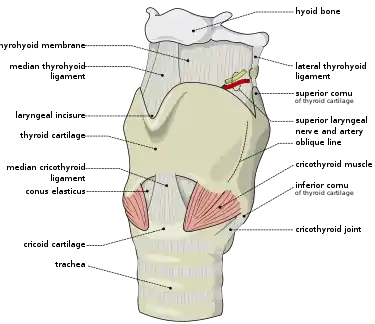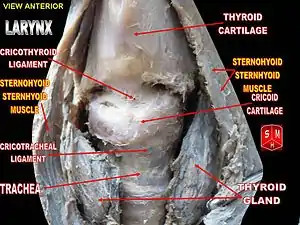Cricothyroid ligament
The cricothyroid ligament (also known as the cricothyroid membrane or cricovocal membrane) is a ligament in the neck. It connects the cricoid cartilage to the thyroid cartilage. It prevents these cartilages from moving too far apart. It is cut during an emergency cricothyrotomy to treat upper airway obstruction.
| Cricothyroid ligament | |
|---|---|
 The ligaments of the larynx. Antero-lateral view. | |
| Details | |
| Identifiers | |
| Latin | Ligamentum cricothyroideum |
| FMA | 55233 |
| Anatomical terminology | |
Structure
The cricothyroid ligament is composed of two parts:
- the median cricothyroid ligament along the midline (a thickening of the cricothyroid membrane). It is a flat band of white connective tissue that connects the front parts of the contiguous margins of the cricoid and thyroid cartilages. It is a thick and strong ligament, narrow above and broad below. Each lateral ligament is known as the conus elasticus.
- the lateral cricothyroid ligaments on each side (these are also called conus elasticus). Each is overlapped on either side by laryngeal muscles.
The conus elasticus (which means elastic cone in Latin) is the lateral portion of the cricothyroid ligament.[1] The lateral portions are thinner and lie close under the mucous membrane of the larynx; they extend from the upper border of the cricoid cartilage to the lower margin of the vocal ligaments, with which they are continuous.[1] The vocal ligaments may therefore be regarded as the free borders of each conus elasticus.[1] They extend from the vocal processes of the arytenoid cartilages to the angle of the thyroid cartilage about midway between its upper and lower borders.
Relations
The prelaryngeal lymph node (also known as the Delphian lymph node) sits anterior to the median cricothyroid ligament.[2]
Function
The cricothyroid ligament prevents the cricoid cartilage and the thyroid cartilage from moving too far apart.
Clinical significance
The cricothyroid ligament is cut during an emergency cricothyrotomy. This kind of surgical intervention is necessary during airway obstruction above the level of vocal folds.
History
The cricothyroid ligament is named after the two structures it connects: the cricoid cartilage and the thyroid cartilage. It is also known as the cricothyroid membrane, and the cricovocal membrane. The various parts of the cricothyroid ligament have been named in many different ways, which can cause confusion.
Other animals
The cricothyroid ligament can be found in many other animals, such as cats,[3] dogs,[3] and horses.[4] The trachea can be accessed through the cricothyroid ligament, such as for aspiration.[3] It can be an important landmark.[4]
Additional images
 Cricothyroid ligament
Cricothyroid ligament Cricothyroid ligament
Cricothyroid ligament Cricothyroid ligament
Cricothyroid ligament Cricothyroid ligament
Cricothyroid ligament Muscles, nerves and arteries of neck.Deep dissection. Anterior view.
Muscles, nerves and arteries of neck.Deep dissection. Anterior view. Cricothyroid ligament
Cricothyroid ligament
References
![]() This article incorporates text in the public domain from page 1078 of the 20th edition of Gray's Anatomy (1918)
This article incorporates text in the public domain from page 1078 of the 20th edition of Gray's Anatomy (1918)
- Brandwein-Gensler, Margaret S.; Mahadevia, Panna; Gnepp, Douglas R. (2009). "5 - Nonsquamous Pathologic Diseases of the Hypopharynx, Larynx, and Trachea". Diagnostic surgical pathology of the head and neck (2nd ed.). Philadelphia: Saunders. pp. 309–411. doi:10.1016/B978-1-4160-2589-4.00005-X. ISBN 978-1-4377-1951-2. OCLC 460904310.
- McGee, Steven R. (2018). "25 - Thyroid and Its Disorders". Evidence-based physical diagnosis (4th ed.). Philadelphia: Elsevier. pp. 203–220. doi:10.1016/B978-0-323-39276-1.00025-1. ISBN 978-0-323-50871-1. OCLC 959371826.
- Burkhard, Mary Jo (2016). "5 - Respiratory Tract". Canine and feline cytology: a color atlas and interpretation guide (3rd ed.). St. Louis: Saunders. pp. 138–190. doi:10.1016/B978-1-4557-4083-3.00005-X. ISBN 978-0-323-24363-6. OCLC 910513174.
- Lane, J Geoffrey (2007). "31 - Fourth Branchial Arch Defects". Equine respiratory medicine and surgery. Edinburgh: Saunders. pp. 467–472. doi:10.1016/B978-0-7020-2759-8.50036-2. ISBN 978-0-7020-2759-8. OCLC 460904360.